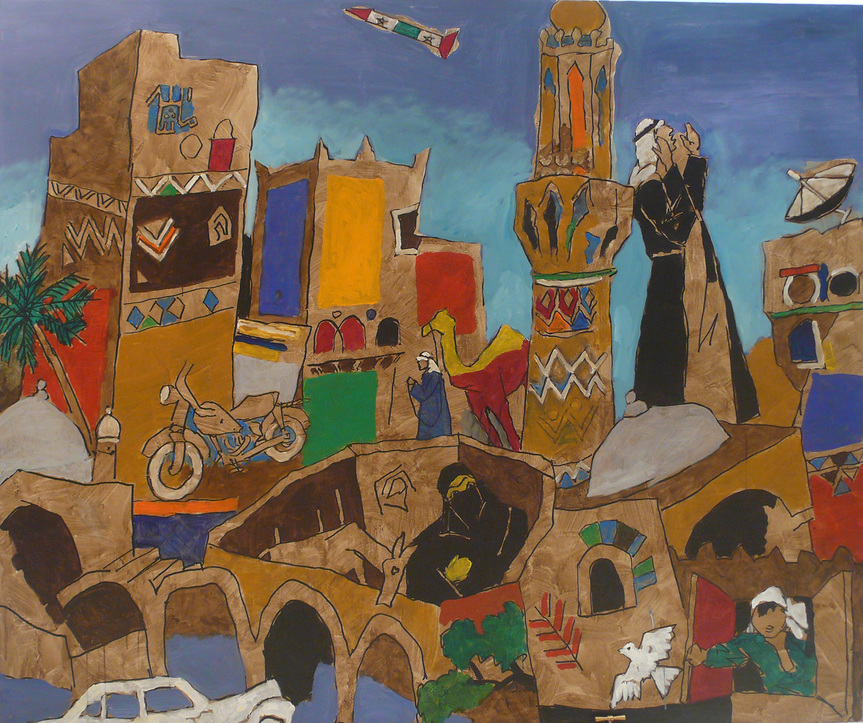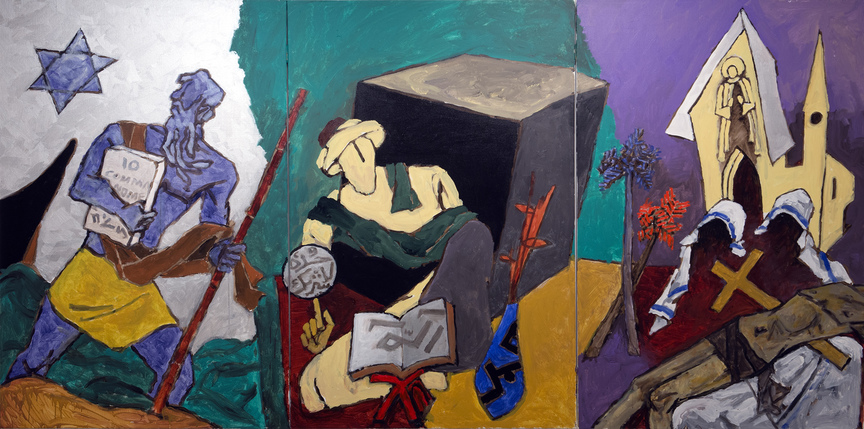-
From Current Issue
-
- Editor’s Letter Fire in the Heart
- Reviews I Gusti Ayu Kadek Murniasih
- Reviews 11th Seoul Mediacity Biennale: “One Escape at a Time”
- Dispatch Networked China
- One on One Monira Al Qadiri on Yukio Mishima
- Essays The rise of independent art spaces in pandemic-era Shanghai
- Features Tuan Andrew Nguyen
- Table of Contents
- Web Exclusives
- Archive
- Subscribe

R
E
V N
E
X
T
Installation view of MF HUSAIN’s “Horses of the Sun” at Mathaf: Arab Museum of Modern Art, Doha. All images courtesy Mathaf.
Whether strolling the streets of Paris and London in cowboy boots, or stepping barefoot into the private colonial colonial-era clubs of Bombay, MF Husain was an itinerant, and not only in terms of geography. A Muslim of Yemeni extraction, his religious and cultural curiosity led him to ponder and portray a variety of faiths and their figures, among them Hindu goddesses depicted in the nude, which riled the Hindu nationalist community in his native India and led to the artist’s self-imposed exile in 2006.
Husain took Qatari citizenship in 2010 having lived out his days mostly between Doha and London, and the former recently honored him with an exhibition at Mathaf: Arab Museum of Modern Art as part of the Qatar-India 2019 Year of Culture. Mathaf is best known as a research institution, but this fails to do justice to the quality and comprehensiveness of its exhibitions. “Horses of the Sun” occupied only three galleries, but had the deservedly elevated feel of a retrospective. Curated by Ranjit Hoskote, ArtAsiaPacific’s Mumbai desk editor, the show explored three related themes that are central to Husain’s work: the idea and memory of home, creativity across different societies and eras, and spiritual pluralism.
The first theme was explored with ample references to the Arab world. In Yemen (2008), Husain composes a colorful and chaotic landscape out of a multitude of planes. Machines, animals and people all face in different directions, implying lines of movement and portraying a vivid dynamism. The idea of home was also explored by more abstract means, as in Call of Desert (2010), where a human figure stretches invitingly over a bowing camel and angular palm trees, all on a canvas split into planes of block color. Husain’s evident romanticizing of his Middle Eastern roots notwithstanding, his birthplace of India was far from overshadowed in either his oeuvre or this exhibition. Mathaf displayed one of several films he made in the 1960s, Through the Eyes of A Painter (1967), in which a sequence of unrelated visuals—linear drawings, cows, umbrellas, faces, lanterns and more—are cut together to give a dynamic, intuitive impression of lived space not unlike that in Yemen. India was also referenced by its religious traditions, as in a series of wonderfully bold lithographs on paper interpreting the Ramayana, one of ancient India’s two major Sanskrit epics.
Husain’s sense of religious and cultural pluralism was more visibly on display in works such as (World Religions) (2008), a triptych portraying the three Abrahamic faiths largely through symbols: Moses and his tablet of commandments, the Kaaba at Mecca, and Jesus
on the cross. The work forms part of 99 paintings on the subject of Islamic civilization that he made in the three years before his death.
In The Last Supper in Red Desert (2008), he borrows the composition of Leonardo Da Vinci’s Last Supper (c. 1495–98) to portray an alternative dining scene in red and gold, here with the playful addition of Arab and Indian references, including another obligatory camel.
A more serious example is Jabir Ibn Hayyan and Ikhwan al-Safa (2008), a portrait of the two eponymous brothers at work with chemistry equipment, which honors more broadly the 8th to 10th-century Arab thinkers to whom we owe much of our mathematical and scientific knowledge. As in so many of the paintings here, the subjects are depicted with a slanting perspective that lends Husain’s paintings a unique sense of almost cinematic kinetic potential, perhaps owing to his earlier passion for filmmaking.
True to its title, the exhibition included a variety of oil paintings showing horses in states of motion. Most notable among these was an untitled piece from 1969 that, using only shades of beige and thick, straight, black lines, generates an incredible sense of movement and energy. Elsewhere, there were wall-hangings in wool depicting desert landscapes and Indian women bearing lotuses, paintings on newspaper, and a series of standing wooden cut-outs with figures painted on them that were apparently made as props for a fashion show organized by his daughter in 1982. All of these objects, placed with great attention to an overall sense of harmony, as well as a collection of thorough and relevant texts born of the high-quality research for which Mathaf is known, made for an excellent exhibition of works by a great modern painter.
MF Husain’s “Horses of the Sun” is on view at Mathaf: Arab Museum of Modern Art, Doha, until July 31, 2019.
To read more ofArtAsiaPacific’s articles, visit our Digital Library.










